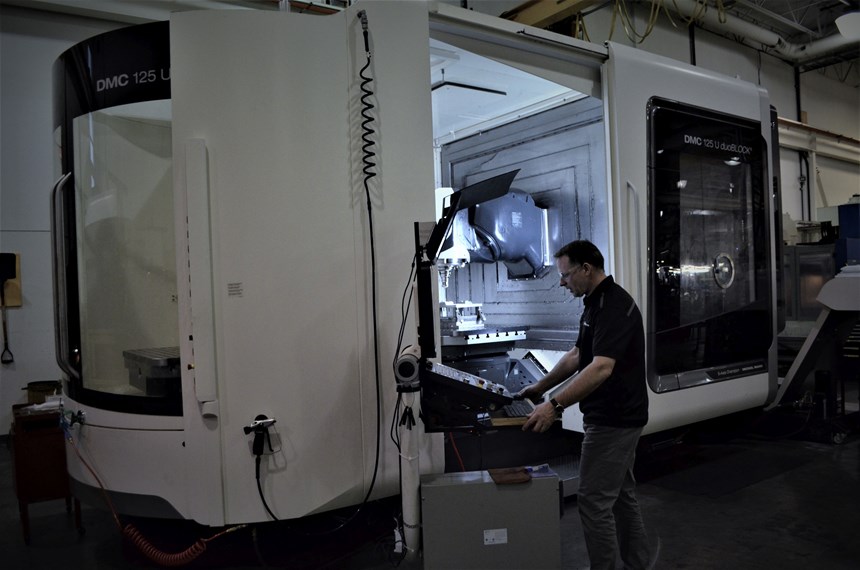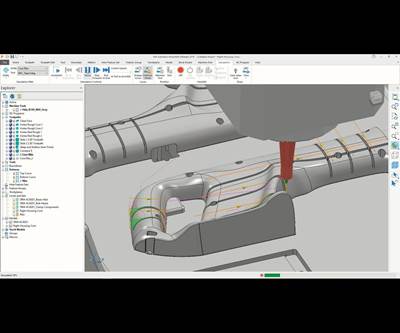Machining is a challenging vocation no matter what you produce. Aerospace shops deal with some of the toughest metals imaginable. Tool and die makers often meet tolerances best measured in microns. Medical manufacturers face complex, three-dimensional part geometries. Now take all three, throw in some deep pockets and long tool overhangs, and you understand the life of a moldmaker.
Granted, there’s a fair amount of overlap among each of these machining specialties, and it’s probably a little unfair to lump people into buckets in this manner, but the fact remains that moldmaking easily ranks among the most demanding of all the manufacturing disciplines.
Someone who can tell you all about it is André Chamberland, CNC programmer at M.I. Integration in Sherbrooke, Quebec, who said one way to make moldmaking life a little bit easier is by eliminating the possibility of a collision between a cutting tool or tool holder and an extremely expensive mold base. The tool he uses to accomplish this is Vericut toolpath simulation and optimization software from CGTech.
Taking on Industrial Moldmaking
The M.I. is short for moules industriels, which in Chamberland’s native French means industrial molds. That description, though accurate, pays short shrift to the breadth of moldmaking-related services this 30-year-old company performs. In 1989, husband and wife team Claude Houle and Francine Guay opened their shop, one that specialized in sealing products for the automotive industry.
Moules Industriels quickly gained a reputation for its high-quality products, and in 1997, the two created a thermoplastic injection division — M.I. Plastech — to better service their clients in search of a turnkey molding solution. As demand rose, they moved the molding business to a new factory (also in Sherbrooke) in 2002, launching M.I. Integration four years later to act as the parent company to the two divisions.
Today, M.I. Integration employs more than 340 people and boasts four facilities, two in Mexico and two in Canada. Francine Guay stepped down as president in 2014 and passed that role to her son Vincent Houle, with her daughter Marie-Claude Houle acting as vice-president of the board.
Protecting Machines and Avoiding Collisions
The company’s growth has not been smooth sailing. Chamberland will tell you that sometime in 2010, management grew tired of replacing spindles on its Huron CNC machining centers. “We were experiencing way too many collisions, mainly because of our deep cavities and big parts, some of which measure 30 by 40 inches across and up to 10 inches deep,” he says. “We needed a way to protect our machines and reduce the downtime and expense that comes with crashed spindles.”
For example, there’ve been instances where the company replaced eight spindles in a single year, each one costing the shop a day or two of downtime, or even three to four weeks if a replacement spindle wasn’t readily available. After looking at the available options, the team chose Vericut toolpath simulation and optimization software.
Chamberland says there was more to the decision than simple crash avoidance. The team wanted the ability to simulate actual post-processed machine code. They wanted to see the entire machine, the spindle, fixtures and tool holding, not the partial view provided by the CAM software. They also wanted to know quickly whether there would be an overtravel condition if the program were placed on another machine tool. And lastly, they needed toolpath simulation software that could read the output from their Cimatron moldmaking software.
Vericut has done all that Chamberland and the other six programmers at M.I. Integration have required, namely preventing all crashes except the ones caused by “human-related setup errors” such as using a tool that is shorter than the one defined during simulation, or placing a fixture in the wrong position.
Going for More
Always on the lookout for improvement opportunities, the team then took Vericut one step further by automating its program simulations. This step eliminates the time spent watching the tool paths — something they already do in Cimatron — and provides a simple thumbs up, thumbs down message from the Vericut server, along with an indication of what tool and program line is causing the problem if one exists.
“I guess we’re a little unique because we don’t run Vericut on our personal computers,” he explains. “Instead, we developed an interface that communicates with Cimatron. When we first got Vericut, this was unavailable, so we wrote our own. All we have to do now is indicate which posted program to verify, enter in the fixture location and the machine to be used and the software then creates a batch file that is sent to a queue on the server.”
When complete, Vericut sends an email to the responsible programmers, telling him or her whether there were any collisions or other errors. The interface leverages standard Vericut functionality to capture images of problem areas, and also sends a picture of the simulated part along with a link to a video, which can be checked with Vericut Reviewer. If changes are needed, the programmer requests access to the software, and the server makes the license available, allowing him or her to correct the problems with tool lengths or overtravels described earlier.
“Vericut has been very useful in preventing collisions, over-travels and other mistakes such as gouging or uncut material that we would prefer to eliminate from our moldmaking processes,” Chamberland says. This has become even more important as the team adapts to five-axis machining with its new DMC 125 U duoBLOCK machining centers from DMG MORI. These machines that, due to an unfamiliar axis configuration and machine control, present M.I.Integration with greater crash potential than their older machining centers. The company is also looking to integrate the new Force optimization module, which uses physics-based modeling to analyze and optimize the cutting conditions based on the material, slowing down where needed and speeding up when possible. The result is significantly shorter cycles times along with much greater tool life.
Meet the Contributor
Gene Granata
Gene Granata is a VERICUT Product Manager.
For More Information
M.I. Integration / (888) 336-3697 / mi-integration.com
CGTech / 949-753-1050 / cgtech.com/ Gene.Granata@cgtech.com
Related Content
Hands-on Workshop Teaches Mold Maintenance Process
Intensive workshop teaches the process of mold maintenance to help put an end to the firefighting culture of many toolrooms.
Read MoreHow to Eliminate Chatter
Here are techniques commonly used to combat chatter and guidelines to establish a foundation for optimizing the moldmaking process.
Read MoreSolving Mold Alignment Problems with the Right Alignment Lock
Correct alignment lock selection can reduce maintenance costs and molding downtime, as well as increase part quality over the mold’s entire life.
Read MoreForces and Calculations Are Key to Sizing Core Pull Hydraulic Cylinders
To select the correct cylinder, consider both set and pull stroke positions and then calculate forces.
Read MoreRead Next
Software Technology Is More Versatile, Efficient and Simplified
Software suppliers are working diligently to provide moldmakers with relevant but easy-to-use solutions that speed processes and lower costs.
Read MoreAccurate Additive Manufacturing Requires Machine Simulation
Machine simulation can help to provide a clear picture of the additive manufacturing process from the first to the last step.
Read MoreReasons to Use Fiber Lasers for Mold Cleaning
Fiber lasers offer a simplicity, speed, control and portability, minimizing mold cleaning risks.
Read More












.png;maxWidth=300;quality=90)






.jpg;maxWidth=300;quality=90)














